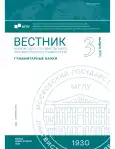Spatial Deixis in Spontaneous Expository Dialogue: Experimental Study
- Authors: Kiose M.I.1
-
Affiliations:
- Moscow State Linguistic University, Institute of Linguistics RAS
- Issue: No 3(897) (2025)
- Pages: 73-80
- Section: Linguistics
- URL: https://journal-vniispk.ru/2542-2197/article/view/286494
- ID: 286494
Cite item
Full Text
Abstract
Featuring the collected data of spontaneous expository dialogues, the study identifies the specific use of spatial deixis which helps construe the relative space within and beyond the communicative situation mediated by its subtypes, close and far. At present, little is known on the role of spatial deixis in modulating space in spontaneous dialogues. The study reveals four types of relative space as well as their distribution in dialogue. The results show the prevalence in the construal of relative space beyond the communicative situation as close, which proves the necessity to move the objects absent in the communicative situation closer to the interlocutor to develop the common ground.
Keywords
About the authors
Maria Ivanovna Kiose
Moscow State Linguistic University, Institute of Linguistics RAS
Author for correspondence.
Email: maria_kiose@mail.ru
Doctor of Philology (Dr. habil.), Assistant Professor, Chief Researcher at Centre for Sociocognitive discourse studies, Moscow State Linguistic University, Leading Researcher at Laboratory of Multichannel communication, Institute of Linguistics
Russian Academy of Sciences
References
- Apresjan, Ju. D. (1986). Deixis in lexis and grammar and the naïve worldview. Semiotics and Informatics, 28, 5–33. (In Russ.)
- Stepanov, Yu. S. (1998). Language and method. To the modern philosophy of language. Moscow: Languages of Russian Culture. (In Russ.)
- Paducheva, E. V. (2008). The regime of interpretation as a context eliminating ambiguity. Computational Linguistics and Intellectual Technologies, 7(14), 412–419. (In Russ.)
- Levinson, S. C. (2003). Space in Language and Cognition: Explorations in Cognitive Diversity. Cambridge: Cambridge University Press.
- Iriskhanova, O. K., Кiose, М. I., Leonteva, A. V., Agafonova О. V. (2022). Multimodal spatial deixis in speech and gesture: frames of reference in explanatory discourse. Issues of Cognitive Linguistics, 4, 17–31. (In Russ.)
- Longacre, R. E. (1983). The grammar of discourse. New York: Plenum.
- Berman, R. A., Nir-Sagiv, B. (2007). Comparing narrative and expository text construction across adolescence: A developmental paradox. Discourse Processes, 43(2), 79–120.
- Apresjan, V. Ju. (2014). Tut, zdes’ i sejchas = On temporal meanings of spatial deictic words. Russian Language and Linguistic theory, 27(1), 9–41. (In Russ.)
- Demyankov, V. Z. (2013). Syntactics, semantics and pragmatics in the scientific heritage of Yu.S. Stepanov. Language parameters of modern civilization (pp. 6–13). Moscow: Institute of Linguistics RAS. (In Russ.)
- Majid, A., Bowerman, M., Kita, S., Haun, D. B. M., Levinson, S. C. (2004). Can language restructure cognition? The case for space. Trends in Cognitive Science, 8, 108–114.
- Levinson, S. C. (2016). Turn-taking in human communication – Origins and implications for language processing. Trends in Cognitive Sciences, 20, 6–14.
- Korotaev, N. А. (2023). Multi-channel interaction in collaborative use of syntactic constructions in dialogue. Computational linguistics and intellectual technologies, 22, 254–266. (In Russ.)
- Gorbyleva, A. V., Shevchenko, T. I. (2023). Friendly Talk-in-Interaction Models Based on Pitch and Pitch Range Parameters. Vestnik of Moscow State Linguistic University. Humanities, 1(869), 48–54.
- Bangerter, A., Clark, H. H. (2003). Navigating joint projects with dialogue. Cognitive Science, 27, 195–225.
Supplementary files










